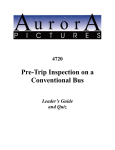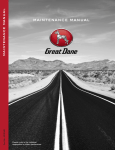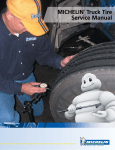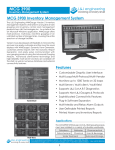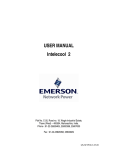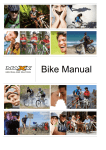Download Dick Cepek Passenger and Light Truck Limited Warranty
Transcript
Dick Cepek Passenger and Light Truck Limited Warranty Eligibility This warranty applies to the original purchaser of a Dick Cepek passenger or light truck tire and is not transferable. Eligible tires must be purchased new and must be used on the vehicle which they were originally installed. Additionally, they must be an equivalent or greater load index to that specified by the vehicle manufacturer. For warranty exclusions see “WHAT ISN’T COVERED”. Standard Coverage If your Dick Cepek branded tire becomes unserviceable as a result of an eligible adjustable condition during the first 2/32" of tread wear, it will be replaced with an equivalent new Dick Cepek tire, FREE OF CHARGE. When the tread is worn more than 2/32", if the product exhibits an eligible adjustable condition, it will be replaced on a pro rated basis. The schedule of tire pro ration is included at the end of the guide. You must present proof of purchase and be the original owner when requesting a replacement for your tire. A replacement charge may be required in order to obtain a replacement tire. The replacement charge will be determined by multiplying the dealer's current selling price by the percentage of original tread depth worn from the tire. You must pay for mounting, balancing, and any other additional charges, such as taxes or the acceptance of a higher priced replacement tire. Any Dick Cepek tire that does not deliver satisfactory service due to a balance, out of round or a ride complaint issue will be replaced without charge within the first 2/32nds of the tire’s tread life. After the first 2/32nds the tire is not warrantable for the aforementioned conditions. Tread Life When the tread becomes worn to 2/32" (1.6mm) anywhere on the tire (shown by tread wear indicators molded into the tread grooves), the tire is worn out. WARNING—for important safety information, you must read the section titled “Tire Service Life” and Important Tire Safety and Fitment Information Warnings section of this guide. How to Obtain an Adjustment Tire adjustments must be presented to the dealer which originally sold the tire. You must be able to provide proof of purchase and be the original owner when requesting a replacement for your tire. See “Where to Go for Warranty Replacement”. What Isn't Covered Adjustments will not be made for: 1. Tires that become unserviceable due to: a. Conditions resulting from road hazards, such as (A) impact damage, (B) cuts, (C) snags, or (D) punctures. b. Conditions such as, but not limited to, uneven, cupping, spotty, feathering tread wear resulting from (A) improper installation, (B) wheel misalignment, (C) tire/wheel assembly imbalance, (D) use of an improper rim, (E) improper mounting or dismounting or (F) improper fitment. c. Conditions resulting from consumer damage, such as, but not limited to, (A) improper tire and vehicle maintenance, (B) misuse, (C) abuse, (D) accident, (E) under inflation, (F) overloading, (G) over deflection, (H) failure to follow recommended rotation practices, (I) cut by vehicle, (J) run flat or (K) improper fitment.. d. Conditions resulting from suspension modifications. 2. Balance, out of round, or ride complaint issues after the first 2/32” of tread wear. 3. The sale of any racing tire or tubes. 4. Tires used in any commercial, racing, or off-road applications. 5. Ozone or weather checking on tires over (4) four years from date of manufacture or date of purchase. Proof of purchase is required. Without proof of purchase the manufacturer date will be used to determine eligibility. 6. Tires stored improperly. 7. Tires that are: a. Worn unevenly and/or show a difference of 2/32” (1.6mm) between the grooves. b. Installed on any vehicle other than the vehicle on which they were first installed. c. Acquired as used (tires purchased used, equipped on a pre-owned vehicle, etc.). d. Altered in any manner (additional siping, buffing, stud pin holes, re-grooving, truing, etc.). e. Worn to 2/32” (1.6mm) or more than 72 months old (based on date of purchase) whichever comes first. Proof of purchase is required. Without proof of purchase, the manufacturer date will be used to determine eligibility. f. Improperly repaired or with repairs not conforming to the Rubber Manufacturer's Association standards. No Road Hazard Coverage Many dealers sell or provide their own warranty coverage for road hazards and/or repairs. Dick Cepek does not provide this coverage. Check with your dealer to determine if Road Hazard/Repair coverage is available from them. Replacement Warranty If you receive a replacement tire under the terms of this Warranty, the replacement tire will be covered by the Warranty then currently given by Dick Cepek for the replacement tire. Where to Go for Warranty Replacement Contact the Dick Cepek dealer where the tire was originally purchased for initial inspection. If the dealer which originally sold the tire is no longer available, please contact Dick Cepek’s technical support department via email at [email protected] or 1-800-222-9092 for assistance in finding a Dick Cepek dealer (Proof of purchase will be required). You may also visit our website Dealer Locator. 58 Conditions and Exclusions Any tire, no matter how well constructed, may fail in service or otherwise become unserviceable due to conditions beyond the control of the manufacturer. Nothing in this Warranty is intended to be a representation by Dick Cepek that tire failure cannot occur. Tire Service Life Dick Cepek recommends that all passenger and light truck tires (including full-size spare tires) that are beyond 10 years from their date of manufacture be replaced with new tires. Tires that are 10 or more years old should be replaced even if the tires appear to be undamaged and have not reached their tread wear limits. In some cases, a vehicle manufacturer may make a recommendation for tire replacement earlier than 10 years for their products based upon their understanding of the specific vehicle characteristics and application. If so, you should follow those vehicle manufacturer's specific recommendations for their vehicle. Tires: Radial Versus Bias Bias tires tend to ride and handle differently than radials. Bias ply or bias belted and radial tires should not be mixed on the same vehicle. Used Tires Never purchase used tires! Previous usage may have damaged internal components. This damage may lead to sudden tire failure. DICK CEPEK DISCLAIMS ANY LIABILITY STEMMING FROM THE USE OF A USED TIRE FOR LOSS OF TIME, OR USE, INCONVENIENCE, OR ANY INCIDENTAL OR CONSEQUENTIAL DAMAGES TO THE EXTENT PERMITTED BY LAW. Consumer Rights THIS WARRANTY DOES NOT IN ANY WAY EXTEND TO ANY CONSEQUENTIAL OR INCIDENTAL DAMAGES OR LOSSES. ALL INCIDENTAL AND CONSEQUENTIAL DAMAGES AND LOSSES ARE HEREBY EXPRESSLY DISCLAIMED AND EXCLUDED FROM THIS WARRANTY. THERE IS NO OTHER WARRANTY, OR LIABILITY, EXPRESSED OR IMPLIED, APPLICABLE TO THESE PRODUCTS. NO REPRESENTATIVE HAS THE AUTHORITY TO MAKE ANY REPRESENTATION, PROMISE, OR AGREEMENT EXCEPT AS STATED HEREIN. Some states do not allow exclusion of incidental or consequential damages. As a result, this limitation or exclusion may not apply to you. This Warranty gives you specific legal rights, and you may also have other rights that vary from state to state. Owner's Obligation When making a claim, you must return the tire to be replaced to the Dick Cepek dealer where the tire was originally purchased for initial inspection. If the dealer which originally sold the tire is no longer available, please contact Dick Cepek’s technical support department via email at [email protected] or 1-800-222-9092 for assistance in finding a Dick Cepek dealer (Proof of purchase will be required). Proper vehicle and tire care is necessary to obtain the expected wear and service from a tire. It is your obligation to properly maintain your tires and the vehicle upon which they are mounted, including: (A) proper fitment, (B) operating your tires at the inflation pressures recommended by the vehicle manufacturer or by your Dick Cepek dealer, (C) keeping your tire/wheel assemblies in balance, (D) proper wheel alignment, and (E) rotation. You must check your tire’s air pressure at least monthly and before long trips. We recommend that you have your Dick Cepek dealer inspect your tires any time you notice irregular of uneven tread wear and rotate them, if necessary. Also, they should be inspected by your dealer any time your vehicle is brought in for service. For additional safety information please visit: www.rma.org, www.nhtsa.gov, www.safercar.gov, or www.nsc.org. IMPORTANT TIRE SAFETY AND FITMENT INFORMATION CHOOSING THE RIGHT TIRE FOR YOUR VEHICLE – OWNER AND USERS OBLIGATION Before choosing and installing any tires on a vehicle, vehicle owners and users must obtain and understand the tire safety and fitment information available (i) in the vehicle’s owners manual and related materials provided with the vehicle, and that can otherwise be obtained from the OE vehicle manufacturer; (ii)available within the industry and from the government; (iii) from the Rubber Manufacturers Association (www.rma.org), and (iv) the National Highway Traffic Safety Administration (www.nhtsa.gov). The user must (i) review and discuss the tire safety and fitment information with their local installer/dealer, including the potential risks associated with not following the tire safety and fitment information; and (ii) have the local tire installer/dealer or a vehicle service professional inspect the vehicle (including any aftermarket modifications) to advise as to any potential risks associated with installing the tires desired by the user on the vehicle. The user must explain the intended service for the vehicle to the local installer/dealer, and the local dealer and installer of the vehicle’s tires are responsible for providing the tire safety information to the user, including the potential risks associated with not following the tire safety and fitment information. In addition, the user may also contact the Dick Cepek tech department at (800) 222-9092 or refer to the information at www.dickcepek.com. If, after doing so and considering this information, the user chooses to assume any potential risk and install a non-OE replacement tire on their vehicle, the fitment of the tire requires, at a minimum, all of the following special considerations are met: INSTALLATION BY TRAINED PROFESSIONAL All tire installations must be done by trained service professionals using proper tools and procedures. Refer to all OE vehicle manufacturer, Rubber Manufacturers Association (www.rma.org), and National Highway Traffic Safety Administration (www.nhtsa.gov) warnings and guidelines. For additional tire safety related information, see the following links: Rubber Manufacturers Association (RMA) Tire Safety Be Smart/Play Your Part Brochure Tire Safety and Care Guide Replacement Guidelines for Passenger and Light Truck Tires National Highway Traffic Safety Administration (NHTSA) Vehicle Safety Tire Safety - Everything Rides On It Failure to follow the tire safety and fitment information may adversely affect the vehicle’s and/or tire’s performance capabilities, including but not limited to the vehicle’s handling/stability capabilities, and could result in tire failure (including tread/belt separation or blowout). UPSIZING AND SUSPENSION LIFTS Due to inconsistencies in vehicle manufacturing and unknown production changes, when "upsizing" to a tire with a larger overall diameter, always consult a local tire dealer/installer (including for vehicles with unmodified OE suspensions). Different suspension lift manufacturers’ requirements may vary. For lifted and/or modified vehicles, always check with the vehicle's suspension lift manufacturer to find the suggested wheel and tire combination and additional safety information. The vehicle’s braking system (including ABS system), tire pressure monitoring system (TPMS), handling characteristics, stability characteristics, speedometer accuracy and transmission shift-points may be affected. Installing tires with a larger outside diameter than the OE tires (or modifying the vehicle's suspension) may create a higher center of gravity fro the vehicle being fitted. This can alter the vehicle's braking, handling and response characteristics. Failure to fully understand the vehicles' altered characteristics could lead to loss of vehicle control, an accident (including rollover) and serious person injury or death. The local dealer/installer are responsible for explaining these differences to the user. Accelerated wear of various OE components on the vehicle may result. Only mount tires on wheels with approved rim widths. For proper rim width ranges, refer to www.dickcepek.com, the Dick Cepek product catalog, or contact the Dick Cepek tech department at (800)222-9092. DO NOT OVERLOAD – DRIVING ON ANY OVERLOADED TIRE IS DANGEROUS The maximum load rating of your tires is marked on the tire sidewall. Do not exceed these load ratings. Tires which are loaded beyond their maximum allowable loads for the particular application will build up excessive heat that may result in sudden tire destruction. Reference the maximum load carrying capacity and load index of the vehicle's specified OE tire as listed on the vehicle’s tire placard and/or certification label. A tire must be selected with a maximum load carrying capacity and load index that is equal to or greater than the vehicle's specified OE tire maximum load carrying capacity and load index. Do not exceed the gross axle weight ratings for any axle on your vehicle. If you anticipate towing a trailer, you should see a local tire installer/dealer for advice concerning the correct size of tire and pressures. Tire size and pressures will depend upon the type and size of trailer and hitch utilized, but in no case must the maximum cold inflation pressure of the tire load rating be exceeded. Check the tire placard and the owner's manual supplied by the manufacturer of your vehicle for further recommendations on trailer towing. SPEED RATED TIRES Reference the speed rating of the vehicle's specified OE tire as listed on the vehicle’s tire placard and/or certification label. A tire must be selected with a speed rating that is equal to or greater than the speed rating of the vehicle's specified OE tire. DRIVING ON ANY TIRE THAT DOES NOT HAVE THE CORRECT INFLATION PRESSURE IS DANGEROUS Any under inflated tire builds up excessive heat that may result in sudden tire destruction. If the replacement tire has a maximum inflation pressure (as listed on the tire sidewall) different than the maximum inflation pressure on the OE tire, then the vehicle’s tire placard must be updated by the installer to reflect the proper inflation pressure for replacement tire. The user may need to make adjustments to inflation pressure, including to prevent overinflation and/or overdeflection of the tires and/or to provide an adequate load carrying capacity as compared to the OE tire. For suggested inflation pressure in the Dick Cepek tires used on the vehicle, contact the vehicle manufacturer and consult the current Tire and Rim Association Year Book, or contact the Dick Cepek tech department at (800) 222-9092. Please have your OE specified tire size and OE cold inflation pressure (located on vehicle’s tire placard), as well as the new tire size available for the tech staff. By providing the inflation pressure information to the user, Dick Cepek is not in anyway recommending or endorsing the use of a tire that does not fully comply with the tire safety and fitment information referred to above. The inflation information is simply being provided (to users who have undertaken the steps discussed above as to understanding the tire safety and fitment information and have knowingly chosen to install the non-OE tire), in order to prevent overinflation and/or overdeflection of the tire and to ensure the replacement tire maintains an adequate level of load carrying capacity as compared to the OE specified tire. Overinflation makes it more likely for tires to be cut, punctured, or damaged by impact. Underinflation, overinflation, cuts, punctures and impacts can cause a tire failure, including tread/belt separation or blower (even at a later date), which under certain circumstances could lead to an accident and serious personal injury or death. CHECK TIRE INFLATION PRESSURES (INCLUDING THE SPARE) AT LEAST ONE A MONTH WHEN TIRES ARE COLD AND BEFORE LONG TRIPS. ALL TIRES LOSE AIR OVER TIME. Failure to maintain correct inflation may result in improper vehicle handling, and may cause rapid and irregular wear, sudden tire destruction, loss of vehicle control and serious personal injury or death. Pressure should be checked when tire are cold; in other words, before they have been driven on. Driving, even a short distance, causes tires to heat up and air pressure to increase. HIGH SPEED DRIVING CAN BE DANGEROUS Correct inflation pressure is especially important. However, at high speeds, even with the correct inflation pressures, a road hazard, for example is more difficult to avoid and if contact is made, has a greater chance of causing tire damage than at a lower speed. Moreover, driving at high speed reduces the reaction time available to avoid accidents and bring your vehicle to a safe stop. Never exceed the speed limit. Always wear your seatbelt. NEVER PURCHASE A USED LIGHT TRUCK OR PASSENGER TIRE Tires can be damages over the course of their service life due to abuse or improper service, poor maintenance, improper repairs, punctures road hazards, or unsuitable storage conditions. Such damage can eventually lead to tire failure. Only the original owner of a new tire can know the full extent of a particular tire's service and maintenance, and the conditions or use or abuse the tires has experienced. INSPECT YOUR TIRES REGULARLY At least once a month inspect your tires closely for signs of uneven wear. Uneven wear patterns may be caused by improper inflation pressures, misalignment, improper balance or suspension neglect. If not corrected, further tire damage will occur. These conditions not only shorten the life of your tires and can lead to sudden tire failure, they adversely affect the handling characteristics of your vehicle which could be dangerous. If any of these conditions exist, the cause may often be corrected at your local tire installer/dealer or other service facility. WORN OUT TIRES ARE DANGEROUS Tires contain "Wear-Bars" in the grooves of the tires tread and indicate when only 2/32nds of an inch (1.6 mm) tread is remaining. Tires worn to 2/32" at any place on the tire, MUST BE REPLACED IMMEDIATELY! TIRES WORN BEYOND THIS STAGE ARE DANGEROUS. TIRE ALTERATIONS ARE DANGEROUS Do not perform any alterations on your tires. Alterations may prevent proper performance, leading to tire damage, which can result in sudden tire destruction. Tires which have been altered are excluded from warranty coverage. REPAIRS If any tire has sustained a puncture, have the tire dismounted and inspected internally by a tire dealer for possible damage that may have occurred. Punctures in certain areas of the tread which do not exceed ¼-inch (6mm) in diameter can be repaired by following the Rubber Manufacturers' Association (RMA) recommended repair procedures. RMA procedures require the use of both a plug and patch. Do not use externally-applied plug repairs. Although it is possible to properly repair many tires, repaired tires should be considered temporary and repaired tires should be replaced as soon as possible. STORAGE Tires should be stored in a cool dry place indoors away from water and from sources of heat and ozone, such as hot pipes and electric motors. Be sure that surfaces on which tires are stored are clean and free from grease, gasoline or other substances which could deteriorate the rubber. Tires exposed to these materials and/or excessive heat for prolonged period of time during storage may be weakened and subject to sudden failure. TIRE ROTATION The rotation pattern indicated in your vehicle manufacturer’s owner’s manual should be followed. If irregular wear becomes apparent or if the rate of wear on the tires is uneven, the tires should be inspected by a tire dealer. Check your vehicle for any mechanical problems and correct if necessary. For tires on front wheel drive vehicles and/or all season tires on any vehicle, it is recommended that these tires be rotated every 8,000 miles to equalize the rate of wear. TIRE MIXING It is recommended that all four tires be of the same size, speed rating, and construction (radial, non-radial). In some cases the vehicle manufacturer may require different sized tires for either the front or rear axles. NEVER mix P-Metric or European Metric passenger tires with light truck sized tires on the same vehicle. Match tire size designations in pairs on an axle, except for temporary use of a spare tire. If two radial tires and two non-radial tires must be used on a vehicle, put radials on the rear axle. If radial and non-radial tires are used on a vehicle equipped with dual rear tires, the radial tires may be used on either axle. Speed rated tires – If the vehicle tire placard and/or owner’s manual specify speed rated tires, the replacement tires must have the same or higher speed rating to maintain vehicle speed capability. If replacement tires have lower speed capability than specified by the vehicle manufacturer, the vehicle’s speed must be restricted to that of the replacement tire. Also, vehicle handling could be affected. Consult vehicle manufacturer or tire manufacturer for recommendations – and consumers should know the speed must be restricted to the limits of the replacement tire. With the exception of winter/snow tires (see below), if tires with different speed ratings are used, it is recommended that the lower speed rated tires should always be placed on the front axle. This is to prevent a potential oversteer condition. Four-wheel drive (4WD) and All-wheel drive (AWD) vehicles- If no instructions for tire mixing appear in the vehicle owner’s manual, follow these guidelines: DO NOT mix tire sizes. All four tires must be marked with the same tire size, unless otherwise specified by the vehicle manufacturer. This also applies to winter/snow tires. DO NOT mix radial and non-radial tires. All four must be either radial or non-radial. DO NOT mix tread pattern types such as all-terrain and all-season. Winter/Snow tires - It is always preferable to apply winter/snow tires to all wheel positions, including duals, to maintain vehicle mobility and control. REPLACING LESS THAN 4 TIRES When replacing tires on a vehicle, it is recommended and preferred that all four tires be replaced at the same time for continued optimal vehicle performance. However, for those cases where this is not feasible, below are some general guidelines to consider when replacing less than four tires for a light vehicle, whether it is one or two tires. If the vehicle manufacturer has alternate recommendations, always follow their recommendations. IMPORTANT In some cases, the vehicle manufacturer may specifically advise against replacing less than all four tires. Always check and follow the recommendations in the vehicle owner’s manual. For 4WD and AWD vehicles, even small differences in outside diameter may cause drive-train damage or mechanical malfunction. Replacing Two (2) Tires – When a pair of replacement tires is selected in the same size and construction as those on the vehicle, the two newer tires should be installed on the rear axles unless the new replacement tires are of a lower speed rating. Generally, new tires with deeper tread will provide better grip and evacuate water more effectively, which is important as a driver approaches hydroplaning situations. Placing greater traction on the rear axle on wet surfaces is necessary to prevent possible oversteer condition and possible loss of vehicle control, especially during sudden maneuvers. Replacing One (1) Tire – Replacing a single tire on a vehicle can have adverse affect on suspension systems, gear ratios, transmission, and tire treadwear. If single tire replacement is unavoidable, it is recommended that the single new tire be paired with the tire that has the deepest tread and both be placed on the rear axle. Placing greater traction on the rear axle on wet surfaces is necessary to prevent a possible oversteer condition and possible loss of vehicle control, especially during sudden maneuvers. TIRE SERVICE LIFE RECOMMENDATION All Dick Cepek tires are designed with conscience efforts to maximize tire life with maximum performance. However, the useful life of a tire is a function of its use, application, and storage conditions. Since these elements can vary widely, and are not controlled by the manufacturer, accurately predicting the life of any specific tire based on calendar age is near impossible. However, Dick Cepek does recognize the benefit of a uniform approach regarding the service life issue. Accordingly, Dick Cepek recommends the following age criteria for removing tires from service even if the tires appear to be undamaged and have not reached their tread wear limits. These dates are based from the manufacturing date, which can be found on the sidewall of your tire. Radial Light Truck Tires – 10 years Passenger Tires – 10 years Under no circumstances should these recommendations be consider as an "expected" service life. Most tires will need to be replaced before these time limits are met due to service conditions. Tires must be removed for several reasons, including: tread worn down to the minimum depth, signs of damage (cuts, cracks, punctures, impact damage, etc), abuse (Long sustained burnouts, overload/under-inflation, improper repair etc), and should be considered for removal in the event of weather checking, misapplication, and performance levels falling off. In some cases a vehicle manufacturer may make a recommendation for tire replacement earlier than Dick Cepek’s recommendations for their products based upon their understanding of the specific vehicle characteristics and application. If so, the consumer should follow those vehicle manufacturer’s specific recommendations for their vehicle. DETERMINING THE AGE OF A TIRE The manufacturing date of a tire is incorporated into an 11 digit code, called a TIN (Tire Identification Number) located down by the bead of the tire. The last four numbers of the TIN represent the week and year of manufacture. In the example below, this tire was produced the 35th week of 2008. EXAMPLE: CY1JM5FJ3508 (3508 = date code) DICK CEPEKPERCENTCREDITCHART-REF1.39.2 REMAININGTREADDEPTHIN32NDSANDCORRESPONDINGPERCENTOFCREDIT 28 28 27 26 100% 100% 100% 26 25 24 100% 100% 85% 81% 88% 84% 22 69% 76% 16 15 65% 72% 79% 62% 68% 75% 83% 58% 64% 71% 78% 54% 60% 67% 74% 86% 82% 50% 56% 63% 70% 77% 20 58% 12% 8% 4% 0% 16% 12% 8% 4% 0% 21% 17% 13% 8% 4% 0% 26% 22% 17% 13% 9% 4% 0% 32% 27% 23% 18% 14% 9% 5% 0% 38% 33% 29% 24% 19% 14% 10% 5% 0% 45% 40% 35% 30% 25% 20% 15% 10% 5% 0% 53% 47% 42% 37% 32% 26% 21% 16% 11% 5% 0% 56% 50% 44% 39% 33% 28% 22% 17% 11% 6% 0% 59% 53% 47% 41% 35% 29% 24% 18% 12% 6% 0% 63% 56% 50% 44% 38% 31% 25% 19% 13% 6% 0% 67% 60% 53% 47% 40% 33% 27% 20% 13% 7% 0% 71% 64% 57% 50% 43% 36% 29% 21% 14% 7% 0% 77% 69% 62% 54% 46% 38% 31% 23% 15% 8% 0% 100% 100% 100% 75% 67% 58% 50% 42% 33% 25% 17% 8% 0% 100% 100% 100% 73% 64% 55% 45% 36% 27% 18% 9% 0% 100% 100% 100% 70% 60% 50% 40% 30% 20% 10% 0% 100% 100% 100% 67% 56% 44% 33% 22% 11% 0% 100% 100% 100% 63% 50% 38% 25% 13% 0% 100% 100% 100% 57% 43% 29% 14% 0% 100% 100% 100% 50% 33% 17% 0% 100% 100% 100% 40% 20% 0% 100% 100% 100% 25% 0% 42% 48% 54% 65% 61% 44% 50% 57% 73% 68% 64% 46% 52% 59% 86% 81% 76% 71% 67% 48% 55% 62% 9 8 85% 80% 75% 70% 50% 57% 65% 100% 100% 100% 38% 35% 31% 27% 23% 19% 15% 40% 36% 32% 28% 24% 20% 42% 38% 33% 29% 25% 43% 39% 35% 30% 45% 41% 36% 48% 43% 50% 84% 79% 74% 52% 60% 68% 100% 100% 100% 83% 78% 55% 63% 72% 58% 67% 61% 18 17 16 15 14 13 100% 100% 100% 82% 76% 71% 65% 100% 100% 100% 81% 75% 69% 100% 100% 100% 80% 73% 100% 100% 100% 79% 100% 100% 100% 12 11 10 9 8 7 6 MATCHTHEORIGINALTREADDEPTHWITHTHEREMAININGTREADDEPTHTODETERMINEPERCENTOFCREDIT 5 6 7 2 46% 52% 19 10 100% 100% 100% 3 11 100% 100% 100% 4 12 87% 13 14 83% 17 21 18 100% 100% 100% 23 73% 80% 88% 19 20 77% 100% 100% 100% 21 100% 100% 100% 22 23 92% 24 88% 25 27 ORIGINALTREADDEPTH -1- REF1.40.04












